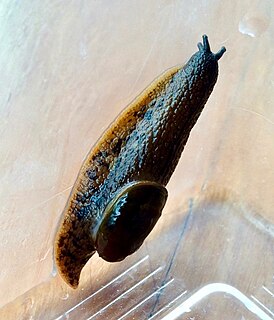
Schizoglossa novoseelandica is a predatory species of air-breathing land slug or semi-slug, a terrestrial gastropod mollusc in the family Rhytididae. It is the type species of the genus Schizoglossa and is found only in New Zealand. The survival of this species is not threatened; it is not listed in the 2009 IUCN Red List nor is it in the 2005 New Zealand Threat Classification System lists.

Hydrocenidae is a taxonomic family of minute land snails or cave snails with an operculum, terrestrial gastropod mollusks or micromollusks in the clade Cycloneritimorpha.

The gastropod shell is part of the body of a gastropod or snail, a kind of mollusc. The shell is an exoskeleton, which protects from predators, mechanical damage, and dehydration, but also serves for muscle attachment and calcium storage. Some gastropods appear shell-less (slugs) but may have a remnant within the mantle, or the shell is reduced such that the body cannot be retracted within (semi-slug). Some snails also possess an operculum that seals the opening of the shell, known as the aperture, which provides further protection. The study of mollusc shells is known as conchology. The biological study of gastropods, and other molluscs in general, is malacology. Shell morphology terms vary by species group. An excellent source for terminology of the gastropod shell is "How to Know the Eastern Land Snails" by John B. Burch now freely available at the Hathi Trust Digital Library.

Planorbidae, common name the ramshorn snails or ram's horn snails, is a family of air-breathing freshwater snails, aquatic pulmonate gastropod molluscs. Unlike most molluscs, the blood of ram's horn snails contains iron-based hemoglobin instead of copper-based hemocyanin. As a result, planorbids are able to breathe oxygen more efficiently than other molluscs. The presence of hemoglobin gives the body a reddish colour. This is especially apparent in albino animals.
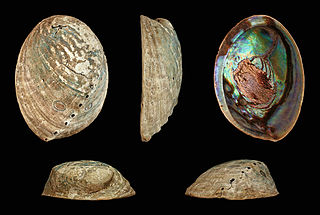
Haliotis iris, common name paua, blackfoot paua or rainbow abalone, is a species of edible sea snail, a marine gastropod mollusk in the family Haliotidae, the abalones.
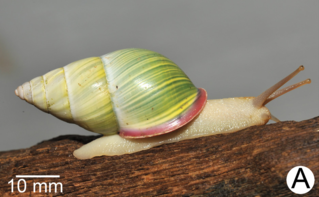
Amphidromus is a genus of tropical air-breathing land snails, terrestrial pulmonate gastropod mollusks in the family Camaenidae. The shells of Amphidromus are relatively large, from 25 mm (0.98 in) to 75 mm (3.0 in) in maximum dimension, and particularly colorful. During the 18th century, they were among the first Indonesian land snail shells brought to Europe by travelers and explorers. Since then, the genus has been extensively studied: several comprehensive monographs and catalogs were authored by naturalists and zoologists during the time period from the early 19th to the mid 20th centuries. Modern studies have focused on better understanding the evolutionary relationships within the group, as well as solving taxonomic problems.

The shoal sprite was a species of minute, air-breathing, freshwater snail, an aquatic pulmonate gastropod mollusk in the family Planorbidae, the ram's horn snails. This species was endemic to Alabama, but it is now extinct.

Neoplanorbis is a genus of small, freshwater, air-breathing snails. They are aquatic pulmonate gastropod mollusks in the family Planorbidae, the ram's horn snails.

Neoplanorbis tantillus is a species of very small air-breathing freshwater snail, an aquatic gastropod mollusk in the family Planorbidae, the ram's horn snails. This species is endemic to the United States. In 2012, it has been declared extinct by the IUCN Red List of Threatened Species.

The columella or pillar is a central anatomical feature of a coiled snail shell, a gastropod shell. The columella is often only clearly visible as a structure when the shell is broken, sliced in half vertically, or viewed as an X-ray image.

Ringicella is a genus of tropical air-breathing land snails, terrestrial pulmonate gastropod mollusks in the family Odontostomidae.

Indrella is a monotypic genus containing the single species Indrella ampulla, a tropical terrestrial air-breathing gastropod mollusk in the family Ariophantidae. It is endemic to the Western Ghats of India.

Haliotis glabra, commonly called glistening abalone, is a species of sea snail, a marine gastropod mollusk in the family Haliotidae, the abalones.
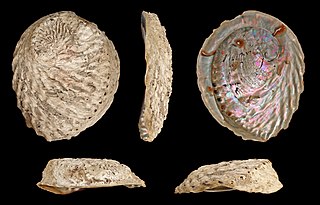
Haliotis midae, known commonly as the South African abalone or the perlemoen abalone, is a species of large sea snail, a marine gastropod mollusk in the family Haliotidae, the abalones.

Lunella ogasawarana is a species of sea snail, a marine gastropod mollusc in the family Turbinidae, the turban snails.

Oospira smithi is a species of air-breathing land snail, a terrestrial gastropod mollusk in the family Clausiliidae, the door snails.

Marstonia comalensis is a species of minute freshwater snail with a gill and an operculum, an aquatic gastropod mollusk or micromollusk in the family Hydrobiidae. It is found in south central Texas, United States.
Bathymophila callomphala is a species of sea snail, a marine gastropod mollusk in the family Solariellidae.
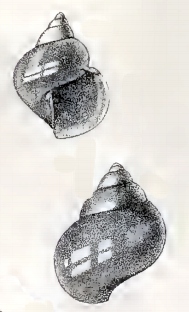
Guttula sibogae is a species of extremely small deep water sea snail, a marine gastropod mollusk in the family Seguenziidae.
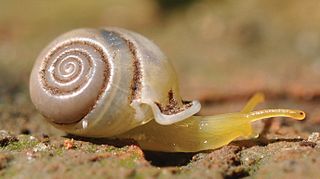
Perrottetia aquilonaria is a species of air-breathing land snail, a terrestrial pulmonate gastropod mollusk in the family Streptaxidae.




















